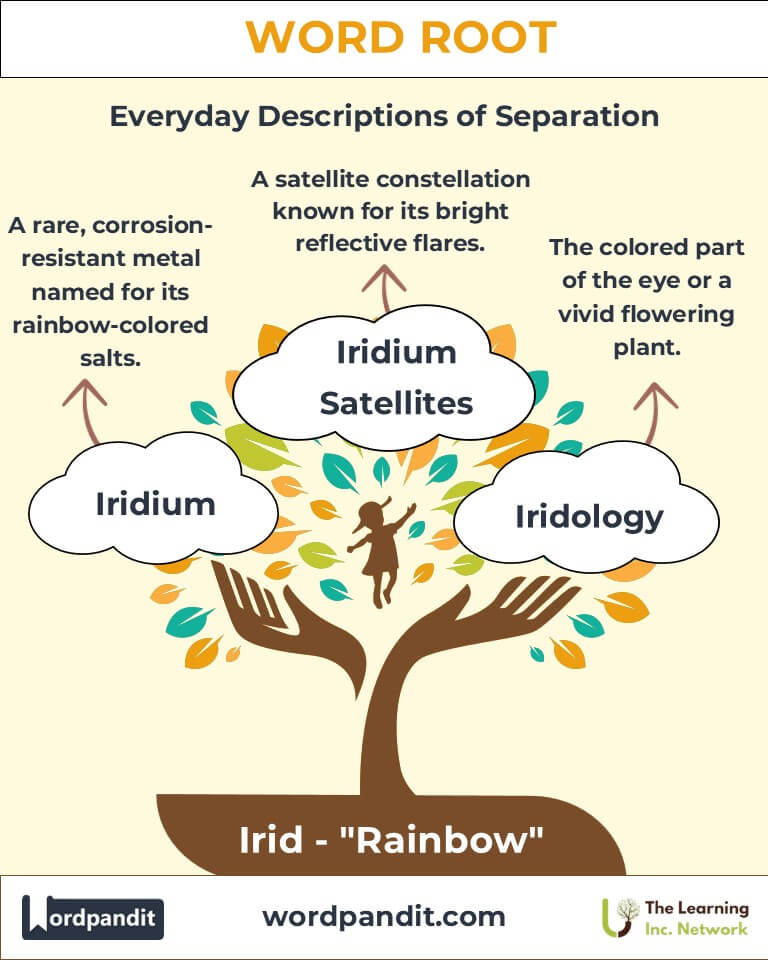
Table of Contents
- Introduction: The Essence of "Irid"
- Etymology and Historical Journey
- Mnemonic: Unlocking the Power of "Irid"
- Common "Irid"-Related Terms
- "Irid" Through Time
- "Irid" in Specialized Fields
- Illustrative Story: "Irid" in Action
- Cultural Significance of the "Irid" Root
- The "Irid" Family Tree
- FAQs about the "Irid" Word Root
- Test Your Knowledge: "Irid" Mastery Quiz
- Conclusion: The Living Legacy of "Irid"
1. Introduction: The Essence of "Irid"
When you gaze upon the dazzling colors of a rainbow or the shimmering surface of a soap bubble, you're witnessing the magic of "Irid." This root, pronounced "eye-rid", originates from the Greek word "iris," meaning "rainbow" or "halo of light." It forms the foundation of terms that celebrate color, brilliance, and diversity, resonating in both everyday and scientific language. From describing shimmering light effects to naming a rare and lustrous metal, "Irid" illuminates a spectrum of meaning across disciplines.

2. Etymology and Historical Journey
The word root "Irid" is deeply rooted in Greek mythology and language. The goddess Iris, a messenger of the gods, personified rainbows as bridges between heaven and earth. This association with colorful, luminous phenomena made "Iris" the perfect metaphor for things that reflect or refract light.
By the 18th century, scientists adopted "Irid" in technical fields. For example, iridium, discovered in 1803, was named for its colorful salts. The root also found its way into language and culture, symbolizing beauty and diversity.
3. Mnemonic: Unlocking the Power of "Irid"
To remember "Irid," imagine a rainbow arcing across the sky, its vivid colors illuminating the world. Think of "Irid" as the root of all things radiant and reflective.
Mnemonic Device: "Irid is the rainbow of words—shining, shimmering, and full of hues."
4. Common "Irid"-Related Terms
- Iridescent (eye-rih-des-uhnt): Displaying a play of colors like those of a rainbow.
- Example: "The soap bubble was iridescent, reflecting a kaleidoscope of hues in the sunlight."
- Iridium (ih-rid-ee-um): A rare, dense, and corrosion-resistant metal, named for its rainbow-like compounds.
- Example: "Iridium is used in spacecraft parts due to its durability and resistance."
- Iris (eye-ris): The colored part of the eye or a flowering plant often displaying vivid colors.
- Example: "Her blue iris sparkled like a clear summer sky."
- Iridology (eye-rih-dol-uh-jee): A pseudoscience focusing on patterns in the iris to diagnose health conditions.
- Example: "Iridology examines the eyes for insights into overall well-being."
5. "Irid" Through Time
- Ancient Mythology: Iris, the Greek goddess, was the divine personification of rainbows, linking the heavens and the earth. Her name inspired poetic descriptions of nature's spectrum.
- Scientific Discovery: Iridium, with its multicolored salts, expanded the root’s application to the elements.
- Modern Symbolism: "Irid" continues to evoke imagery of diversity, brilliance, and connection.
6. "Irid" in Specialized Fields
- Optics:
- Term: Iridescence – The phenomenon of colorful light reflections seen in thin films or bubbles.
- Use: Vital in studying light wave interference.
- Astronomy and Space Exploration:
- Term: Iridium Satellites – A communication satellite constellation known for reflective flares visible from Earth.
- Biology:
- Term: Iris – The structure controlling light entering the eye or naming a vibrant genus of flowers.
7. Illustrative Story: "Irid" in Action
On a sunny afternoon, Maya marveled at an iridescent dragonfly dancing over the water. Inspired by its shimmering wings, she decided to study optics. Years later, Maya developed cutting-edge iridescent materials for eco-friendly solar panels. Like the dragonfly that sparked her curiosity, her work reflected the beauty and potential of the "Irid" root.
8. Cultural Significance of the "Irid" Root
The concept of "Irid" transcends language and science. Rainbows are universally seen as symbols of hope and diversity. The iris flower often represents wisdom and courage, while the vibrant human iris adds individuality to our expressions. The rainbow's enduring symbolism in art, mythology, and social movements underscores the root’s cultural resonance.

9. The "Irid" Family Tree
- Chrom- (Greek: "color")
- Term: Chromatic – Relating to colors.
- Example: "The chromatic spectrum is a feast for the eyes."
- Luc- (Latin: "light")
- Term: Lucid – Bright or clear.
- Example: "Her explanation was as lucid as the night sky."
- Spec- (Latin: "look")
- Term: Spectacle – A visually striking display.
- Example: "The aurora was a natural spectacle of light."
10. FAQs About the "Irid" Word Root
Q: What does "Irid" mean?
A: "Irid" means "rainbow" or "something radiant." It originates from the Greek word iris, which referred to both the rainbow in the sky and the goddess Iris in mythology, who symbolized the connection between heaven and earth. Today, "Irid" is used in contexts that evoke brilliance, color, and light, as seen in words like "iridescent."
Q: What is iridescence?
A: Iridescence refers to the phenomenon where surfaces display changing colors depending on the angle of view or light. This effect is caused by light wave interference, often seen in soap bubbles, oil slicks, or bird feathers. The root "Irid" captures this shimmering quality, reflecting its association with rainbows.
Q: Why is the element iridium named after "Irid"?
A: The metal iridium was named for its colorful compounds that display rainbow-like hues. Discovered in 1803, iridium's name reflects the "Irid" root's symbolic connection to color and brilliance, further showcasing its influence in science and chemistry.
Q: What role does the iris play in the human eye?
A: The iris, the colored part of the eye, regulates the amount of light entering the eye by controlling the size of the pupil. This action ensures clear vision in varying lighting conditions. Its name comes from "Irid" because of its vibrant colors, akin to the shades of a rainbow.
Q: Is iridology a proven science?
A: Iridology is a pseudoscience that claims to diagnose health issues by examining patterns and colors in the iris of the eye. However, it lacks empirical evidence and is not recognized by medical professionals. The association with "Irid" lies in its focus on the colorful and patterned iris.
Q: How does "Irid" relate to culture and symbolism?
A: "Irid" connects to the rainbow, a universal symbol of hope, diversity, and connection. In mythology, the goddess Iris bridged the heavens and earth, and in modern times, rainbows symbolize inclusivity and beauty. This cultural significance enriches the linguistic and metaphorical usage of the root.
11. Test Your Knowledge: "Irid" Mastery Quiz
1. What does "Irid" mean?
2. What does iridescent describe?
3. Which element is linked to "Irid"?
4. What is the function of the iris in the eye?
5. Where can iridescence commonly be observed?
12. Conclusion: The Living Legacy of "Irid"
The root "Irid" symbolizes the spectrum of color, reflection, and diversity, from ancient myths to modern science. It reminds us to marvel at the rainbows in our world—literal and metaphorical. As our understanding of light and materials grows, "Irid" will continue to shine in both language and discovery.












